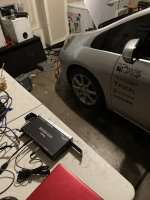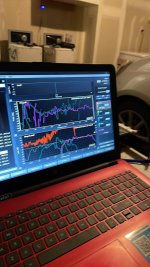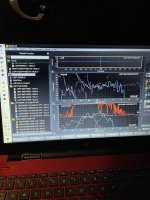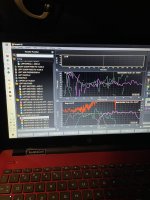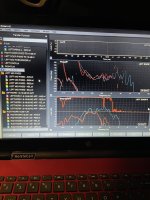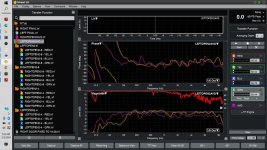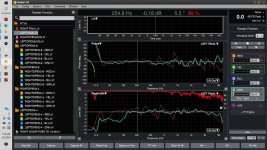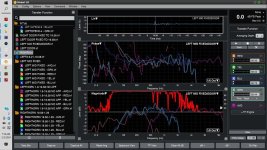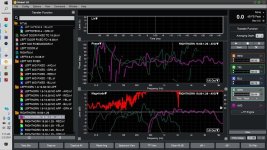So, I made some FIRs for every speaker. I have just finished a tune where I used the time of flight removal , the “find” feature in smaart only on the HF drivers.
Then I aligned each lower frequencies to the time of flight from the Hf.
Before I would do tape measurement distance then use find and then convolve to that.
Now, I used signal delay and off the HF “find” have removed as much phase as possible, then convolve to that…
Both ways yield similar results. Which one is superior? It’s close to tape distances but not quite, I noticed also a can convolve out signal delay, if I used a different delay for the speaker I can convolve the wraps and make it the correct delay… weird
Any insight on this subject is helpful. How exactly does this stuff work
I have unequal path lengths and my room is a metal box and I sit in the corner.
@pos @fluid @wesayso @mark100
Then I aligned each lower frequencies to the time of flight from the Hf.
Before I would do tape measurement distance then use find and then convolve to that.
Now, I used signal delay and off the HF “find” have removed as much phase as possible, then convolve to that…
Both ways yield similar results. Which one is superior? It’s close to tape distances but not quite, I noticed also a can convolve out signal delay, if I used a different delay for the speaker I can convolve the wraps and make it the correct delay… weird
Any insight on this subject is helpful. How exactly does this stuff work
I have unequal path lengths and my room is a metal box and I sit in the corner.
@pos @fluid @wesayso @mark100
Attachments
So my question
Setting delays
When convolving FIRs , as long as I convolve it to the time of flight settings for the HF driver, do delays matter?
It seems I can convolve out or in signal delay and the delay setting on dsp doesn’t need to make sense with the rest of system
OR, is it more proper and does it make an audible difference if ; I set delays to actual tape distances then convolve out all the extra wraps ? (Of course again using time of flight from HF driver)
Maybe I need someone to explain casualty again to me.
Setting delays
When convolving FIRs , as long as I convolve it to the time of flight settings for the HF driver, do delays matter?
It seems I can convolve out or in signal delay and the delay setting on dsp doesn’t need to make sense with the rest of system
OR, is it more proper and does it make an audible difference if ; I set delays to actual tape distances then convolve out all the extra wraps ? (Of course again using time of flight from HF driver)
Maybe I need someone to explain casualty again to me.
It seems I can convolve out or in signal delay and the delay setting on dsp doesn’t need to make sense with the rest of system
OR, is it more proper and does it make an audible difference if ; I set delays to actual tape distances then convolve out all the extra wraps ? (Of course again using time of flight from HF driver)
Hi Andrew, as you found, you can put the delay in as a distinct and separate delay in the dsp, or embed the delay into the FIR filter.
I like to use a separate distinct delay.
It's a reality check for me, to make sure the delay equals the distance between acoustic centers. I've found that the degree the fixed delay converges on the exact distance between drivers' acoustics centers, the more confident I am the tuning is correct (and better polars show it too)
I also like to use a distinct delay, because then I can swap out, experiment with, different FIR files without being concerned about timing.
Here's how I use Smaart for this...
Like you, I start with the Delay finder for the VHF section. Then from the locked mic position, I find the delay to each of the driver sections.
The delta between the VHF section delay, and the other sections, is what I put into DSP delays for each.
Sometimes of course, you have to add delay to the starting VHF measurement, just to be able to add positive delays to the other sections.
BTW, what software are you using to make your FIR files, and what kind of tap count availability do you have per channel?
Depending, I've found some neat tricks I like for getting more accurate/consistent Delay finder times for the low frequency drivers.
Lemme know, and I'll continue on....
Thanks @mark100
I’m using rePhase. Thank you
2x4HD modules for drivers and OpenDrc upstream
1024 taps on each speaker (except sub is all IIR)
The horns I need 2042 taps because they play really low (500hz) and the amount of wraps needed more then the 5.33ms of fir to get phase good down to 80hz on horns.
On sub , I’ve used a crossover that matches the midbass twist on the midbass HPF and erase that in OpenDrc in one swoop
Everything else fir is done at each speaker.
What’s the trick
I’m using rePhase. Thank you
2x4HD modules for drivers and OpenDrc upstream
1024 taps on each speaker (except sub is all IIR)
The horns I need 2042 taps because they play really low (500hz) and the amount of wraps needed more then the 5.33ms of fir to get phase good down to 80hz on horns.
On sub , I’ve used a crossover that matches the midbass twist on the midbass HPF and erase that in OpenDrc in one swoop
Everything else fir is done at each speaker.
What’s the trick
Last edited:
Ok, I was hoping you use / have available the same FIR tap count for each driver channel. That makes the 'trick' I use easier, because it makes setting delays simpler.
In a nutshell, the trick is to have a FIR filter in place for all raw measurements. (preferably all the same size, and all with impulse centering.
And use linear-phase low pass filters for making raw measurement of all drivers below the VHF/HF section.
For instance: On the VHF/HF section, using 4096 taps as an example, I put a FIR file in with zero corrections. With this FIR file in place, I then get a raw measurement that sets the overall reference time, with FIR time included. (a linear phase high pass can be put in for driver protection, but keep it well below the intended final high pass frequency.)
Then, for each lower driver section, I put in the 4096 tap FIR file with a linear phase low pass, that is as low as possible but still well above the drivers intended low pass freq.
For instance, on your mid driver which is contributing up to 1-2kHz, to take its raw measurement, I'd have about a 4-8kHz lin-phase low pass in place.
Reason for the low-pass is Smaart uses the peak ETC curve for finding delay.
When a driver has significant response above the intended passband, such as out of band peaks, the ETC peak gets moved forward in time a little.
But it's slightly bogus timing because we are only interested in the timing of the drivers response where its response is the flattest....the passband.
Play with different low pass frequencies and you'll see what I mean about their effect on both delay finder time and the phase trace of the intended pass band.
Of course, the low-pass being used for raw meas must be lin phase, and I've found steeper works better.
Do this for each subsequent lower driver section, using a low pass that fits each of the intended passbands, and the delay finder times will be more in line with determining the DSP delays that make them equal the distances between drivers' acoustic centers.
If using REW, taking measurements with 0 timing offset, measured against loopback, will give the same set of DSP delays that using Smaart's delay finder does. So it appears to me REW, and all others I've tried use ETC peak too.
In a nutshell, the trick is to have a FIR filter in place for all raw measurements. (preferably all the same size, and all with impulse centering.
And use linear-phase low pass filters for making raw measurement of all drivers below the VHF/HF section.
For instance: On the VHF/HF section, using 4096 taps as an example, I put a FIR file in with zero corrections. With this FIR file in place, I then get a raw measurement that sets the overall reference time, with FIR time included. (a linear phase high pass can be put in for driver protection, but keep it well below the intended final high pass frequency.)
Then, for each lower driver section, I put in the 4096 tap FIR file with a linear phase low pass, that is as low as possible but still well above the drivers intended low pass freq.
For instance, on your mid driver which is contributing up to 1-2kHz, to take its raw measurement, I'd have about a 4-8kHz lin-phase low pass in place.
Reason for the low-pass is Smaart uses the peak ETC curve for finding delay.
When a driver has significant response above the intended passband, such as out of band peaks, the ETC peak gets moved forward in time a little.
But it's slightly bogus timing because we are only interested in the timing of the drivers response where its response is the flattest....the passband.
Play with different low pass frequencies and you'll see what I mean about their effect on both delay finder time and the phase trace of the intended pass band.
Of course, the low-pass being used for raw meas must be lin phase, and I've found steeper works better.
Do this for each subsequent lower driver section, using a low pass that fits each of the intended passbands, and the delay finder times will be more in line with determining the DSP delays that make them equal the distances between drivers' acoustic centers.
If using REW, taking measurements with 0 timing offset, measured against loopback, will give the same set of DSP delays that using Smaart's delay finder does. So it appears to me REW, and all others I've tried use ETC peak too.
Okay interesting. What about in a highly reflective environment like a car, A lot of the phase is excess phase. So zeroing it out with a peak find using the ETC should keep the direct sound timing right, but where reflections dominate, it seems to work better using a static mic time from vhf…
But the issue that I’m running into doing it with a static mic, is it does remove a ton of reflections and the decay sounds a lot better, but the unequal path lengths seem to have caused a new problem.
If my PLD is let’s say 1ms, and I use static mic for all drivers, then linearizing that makes it in phase at the mic position, but out of phase as far as relative polarity goes sorta. Like any frequencies that are equal to the distance the left and right are apart at 1ms become -180 at the speaker….
So left and right speakers don’t interact properly and reinforce eachother properly when mono signals in music pass through…
So I gain really good time behavior per ch, but I loose reinforcement on mono signals. So each channel sounds dry and a tad bit harsh in those areas as it seems the reflected sound and direct sound are a mismatch.
Before when I used a find on each driver and linearized that I didn’t have those issues, so maybe the acoustic center has something to do with it. Doing it with a static mic has far better audio qualities I just needed to get it to sound good..
Do you think this is something where a frequency time window would be something I would want to consider?
Thank you
But the issue that I’m running into doing it with a static mic, is it does remove a ton of reflections and the decay sounds a lot better, but the unequal path lengths seem to have caused a new problem.
If my PLD is let’s say 1ms, and I use static mic for all drivers, then linearizing that makes it in phase at the mic position, but out of phase as far as relative polarity goes sorta. Like any frequencies that are equal to the distance the left and right are apart at 1ms become -180 at the speaker….
So left and right speakers don’t interact properly and reinforce eachother properly when mono signals in music pass through…
So I gain really good time behavior per ch, but I loose reinforcement on mono signals. So each channel sounds dry and a tad bit harsh in those areas as it seems the reflected sound and direct sound are a mismatch.
Before when I used a find on each driver and linearized that I didn’t have those issues, so maybe the acoustic center has something to do with it. Doing it with a static mic has far better audio qualities I just needed to get it to sound good..
Do you think this is something where a frequency time window would be something I would want to consider?
Thank you
- Home
- Loudspeakers
- Multi-Way
- FIR filters on every driver in a 4 way with Smaart data.
